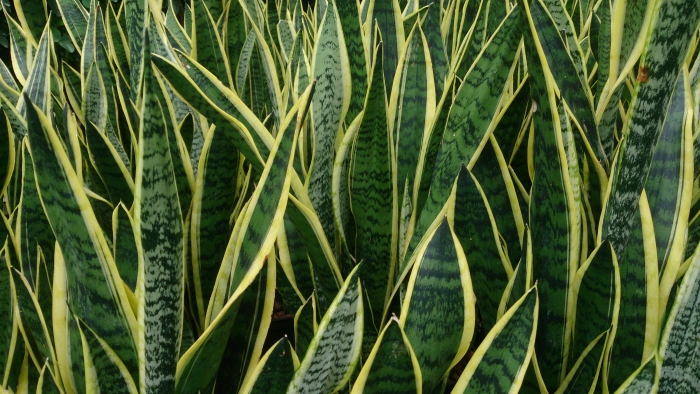Snake Plant
(Sansevieria trifasciata)
Snake Plant (Sansevieria trifasciata)
/
/

Mokkie
CC BY-SA 3.0
Image By:
Mokkie
Recorded By:
Copyright:
CC BY-SA 3.0
Copyright Notice:
Photo by: Mokkie | License Type: CC BY-SA 3.0 | License URL: https://creativecommons.org/licenses/by-sa/3.0 | Uploader: Mokkie | Publisher: Wikimedia Commons | Title: Snake_Plant_(Sansevieria_trifasciata_'Laurentii').jpg | Notes: Description: Sarracenia leucophylla Photo taken by: Noah Elhardt (own work) |






















































Estimated Native Range
Summary
Sansevieria trifasciata, commonly known as Snake Plant or Mother-in-Law’s Tongue, is an evergreen perennial herb native to tropical West Africa from Nigeria east to the Congo. It is not a subshrub, but rather a succulent that can reach heights of up to 2 meters (6 feet) under optimal conditions, though it is more commonly seen at heights of 70-90 cm (28-35 inches). It has stiff, upright leaves that are dark green with light gray-green horizontal stripes. This plant is adapted to survive arid conditions and is found in a variety of habitats, including rocky outcrops and dry savannahs, where it can form dense stands.
The Snake Plant is highly valued for its air-purifying qualities, removing toxins such as formaldehyde and benzene from indoor environments. It is a popular choice for indoor spaces due to its architectural form and low maintenance requirements. It is also used in outdoor landscaping in tropical and subtropical climates. The Snake Plant prefers bright, indirect light but can tolerate lower light levels, making it suitable for a variety of indoor settings. It requires well-drained soil and should be watered sparingly to avoid root rot. While it rarely blooms in cultivation, when it does, the flowers are greenish-white and appear on a very long flower stalk. It is commonly propagated by leaf cuttings or division, with the latter method preserving the variegation of the leaves. Potential problems include root rot due to overwatering and mealybugs or spider mites if grown in too humid an environment.CC BY-SA 4.0
The Snake Plant is highly valued for its air-purifying qualities, removing toxins such as formaldehyde and benzene from indoor environments. It is a popular choice for indoor spaces due to its architectural form and low maintenance requirements. It is also used in outdoor landscaping in tropical and subtropical climates. The Snake Plant prefers bright, indirect light but can tolerate lower light levels, making it suitable for a variety of indoor settings. It requires well-drained soil and should be watered sparingly to avoid root rot. While it rarely blooms in cultivation, when it does, the flowers are greenish-white and appear on a very long flower stalk. It is commonly propagated by leaf cuttings or division, with the latter method preserving the variegation of the leaves. Potential problems include root rot due to overwatering and mealybugs or spider mites if grown in too humid an environment.CC BY-SA 4.0
Plant Description
- Plant Type: Herb
- Height: 2-4 feet
- Width: 1-2 feet
- Growth Rate: Moderate
- Flower Color: Cream, White
- Flowering Season: Spring, Summer, Winter
- Leaf Retention: Evergreen
Growth Requirements
- Sun: Part Shade
- Water: Medium
- Drainage: Fast, Medium, Slow
Common Uses
Drought Tolerant, Fragrant, Groundcover, Low Maintenance, Potted Plant, Rock Garden, Street Planting
Natural Habitat
Native to rocky outcrops and dry savannahs in tropical West Africa
Other Names
Common Names: Mother-In-Law’s Tongue , Viper’s Bowstring Hemp , Saint George’s Sword , Svärmorstunga , 虎尾蘭
Scientific Names: Sansevieria trifasciata , Dracaena trifasciata , Sansevieria laurentii , Sansevieria craigii , Sansevieria trifasciata var. laurentii , Sansevieria trifasciata var. trifasciata , Sansevieria zeylanica var. laurentii , Dracaena trifasciata subsp. sikawae , Aletris hyacinthoides var. zeylanica , Sansevieria aureovariegata
GBIF Accepted Name: Sansevieria trifasciata Prain